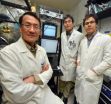(Press-News.org) In this week's issue of the prestigious journal Nature Chemical Biology, scientists Carole Linster (University of Luxembourg), Emile Van Schaftingen (Louvain University), and Andrew D. Hanson (University of Florida, Gainesville) review an important, but so far neglected, part of metabolism, namely metabolite damage-control. In their publication 'Metabolite damage and its repair or pre-emption', the authors present a comprehensive overview of the known reactions generating unwanted small molecules in the cell as well as of the corresponding control mechanisms, and discuss the importance of this 'quality control' for cellular and organismal health.
"Damage-control in metabolism represents an entirely new concept, that shifts our view from linear metabolic pathways sustained by highly specific enzymes to more complex networks that take into account numerous damage and repair reactions", explains Dr. Carole Linster, a young group leader at the Luxembourg Centre for Systems Biomedicine (LCSB), and hopes that her and others new research findings will lead to a change of paradigm in metabolism.
The molecules that constitute living cells are constantly subject to damaging reactions and fixing this damage immediately is crucial for cellular health and survival. Damage-control must therefore have existed since the dawn of life, and the repair mechanisms that cells have adopted throughout evolution have been studied by scientists for decades. But until recently, most researchers have focused their attention on the repair mechanisms acting on large molecules such as DNA and proteins, while damage-control of small molecules, called metabolites, has mostly been overlooked. Linster explains this oversight: "Classical biochemistry taught us that, given the high substrate specificity of enzymes, metabolic reactions are very precise processes which don't generate any useless or toxic by-products. But thanks to new technologies we have learned that this is not the case, and that the cell is likely to constantly produce damaged metabolites, which have to be eliminated or repaired." A deficiency in metabolite repair can lead to fatal disease in humans.
The field of 'metabolite damage-control' is still in its infancy and biochemists are just starting to understand how the cell repairs damaged metabolites. This suggests that many metabolite damage-control systems remain to be discovered. "I hope that scientists who read this review will be convinced that metabolite repair is an important aspect of cell metabolism", says Linster. "It should inspire researchers to look for yet unidentified reactions and thereby improve our understanding of the extent of metabolite damage-control and the physiological importance thereof."
### END
How our cells cope with toxic small molecules
Metabolite damage-control
2013-01-30
ELSE PRESS RELEASES FROM THIS DATE:
How does fibrosis occur in Crohn's disease?
2013-01-30
New research has shown that a protein, known as IL-13, could be the key to the development of fibrosis in Crohn's disease. This breakthrough could help to advance new medicines to treat people suffering with the disease.
Crohn's disease is a chronic, debilitating condition characterised by inflammation and ulceration occurring at any point in the gastrointestinal tract. Currently there is no cure. One of the major complications of Crohn's disease is the development of fibrosis – hardening and thickening – in the bowel wall. This causes the intestine to lose its mobility ...
Academic gains, improved teacher relationships found among high risk kids in Head Start
2013-01-30
BEND, Ore. – A new study by Oregon State University researchers finds that Head Start can make a positive impact in the lives of some of its highest risk children, both academically and behaviorally.
Published in the current issue of the Journal of Applied Developmental Psychology, the study sheds light on how Head Start has helped children living in non-parental care, or living with someone who is not a parent or step-parent by biology or adoption.
"These children tend to have unstable home lives, sometimes transitioning between different relatives, living with their ...
Snails signal a humid Mediterranean
2013-01-30
An international team of researchers has shown that old wives' tales that snails can tell us about the weather should not be dismissed too hastily.
While the story goes that if a snail climbs a plant or post, rain is coming, research led by the University of York goes one better: it shows snails can provide a wealth of information about the prevailing weather conditions thousands of years ago.
The researchers, including scientists from the Scottish Universities Environmental Research Centre (SUERC), analysed the chemistry of snail shells dating back 9,000 to 2,500 years ...
Scientists learn more about how inhibitory brain cells get excited
2013-01-30
AUGUSTA, Ga. – Scientists have found an early step in how the brain's inhibitory cells get excited.
A natural balance of excitement and inhibition keeps the brain from firing electrical impulses randomly and excessively, resulting in problems such as schizophrenia and seizures. However excitement is required to put on the brakes.
"When the inhibitory neuron is excited, its job is to suppress whatever activity it touches," said Dr. Lin Mei, Director of the Institute of Molecular Medicine and Genetics at the Medical College of Georgia at Georgia Regents University ...
A new genre of 'intelligent' micro- and nanomotors
2013-01-30
Enzymes, workhorse molecules of life that underpin almost every biological process, may have a new role as "intelligent" micro- and nanomotors with applications in medicine, engineering and other fields. That's the topic of a report in the Journal of the American Chemical Society, showing that single molecules of common enzymes can generate enough force to cause movement in specific directions.
Peter J. Butler, Ayusman Sen and colleagues point out that enzymes — proteins that jump-start chemical reactions — are the basis of natural biological motors essential to life. ...
Penn research shows mechanism behind wear at the atomic scale
2013-01-30
PHILADELPHIA — Wear is a fact of life. As surfaces rub against one another, they break down and lose their original shape. With less material to start with and functionality that often depends critically on shape and surface structure, wear affects nanoscale objects more strongly than it does their macroscale counterparts.
Worse, the mechanisms behind wear processes are better understood for things like car engines than nanotech devices. But now, researchers at the University of Pennsylvania's School of Engineering and Applied Science have experimentally demonstrated ...
Researchers improve medical units to reduce nursing fatigue, cut costs
2013-01-30
ITHACA, N.Y. – In hospitals, poor floor design, storage closet clutter and crowded corridors can contribute to nurse and medical staff fatigue. These distractions can hurt patient care quality and result in higher medical costs.
Now, a new Cornell University study offers a spatial solution.
Rana Zadeh, Cornell assistant professor of design and environmental analysis in the College of Human Ecology, analyzed the floor plans and work patterns within five medical-surgical units at U.S. hospitals and found numerous opportunities to boost nurses' efficiency through better ...
Conflicting cultural identities may foster political radicalism
2013-01-30
New research suggests that dual-identity immigrants — first-generation immigrants and their descendants who identify with both their cultural minority group and the society they now live in — may be more prone to political radicalism if they perceive their two cultural identities to be incompatible.
The new research is published in Psychological Science, a journal of the Association for Psychological Science.
Psychological scientist Bernd Simon from Kiel University in Germany and colleagues hypothesized that perceived incompatibility between the two cultural identities ...
Aging cells lose their grip on DNA rogues
2013-01-30
PROVIDENCE, R.I. [Brown University] — Even in our DNA there is no refuge from rogues that prey on the elderly. Parasitic strands of genetic material called transposable elements — transposons — lurk in our chromosomes, poised to wreak genomic havoc. Cells have evolved ways to defend themselves, but in a new study, Brown University researchers describe how cells lose this ability as they age, possibly resulting in a decline in their function and health.
Barbara McClintock, awarded the Nobel Prize in 1983, made the original discovery of transposons in maize. Since then ...
GEOLOGY starts 2013 with 25 new articles posted online ahead of print
2013-01-30
Boulder, Colo., USA - Geology content posted online 4 through 25 January 2013 cover topics from greenhouse gas emissions to video observations of erupting geysers in Russia and from the age of Earth to the age of Grand Canyon. Highlights and detailed information about each article are listed below.
1. Earth is mostly flat
2. Age maps of early Earth
3. Sagaing fault, Indo-Burmese wedge
4. Anthropogenic lead
5. The growth of a newly born submarine volcano
6. The Hemlo gold deposit, Ontario, Canada
7. Reptile and mammal fossils in the Karoo Basin, South Africa
8. ...
LAST 30 PRESS RELEASES:
Manta rays create mobile ecosystems, study finds
Study: Mixed results in using lipoic acid to treat progressive multiple sclerosis
Norbert Holtkamp appointed director of Fermi National Accelerator Laboratory
New agentic AI platform accelerates advanced optics design
Biologists discover neurons use physical signals — not electricity — to stabilize communication
Researchers discover that a hormone can access the brain by hitchhiking
University of Oklahoma researcher awarded funding to pursue AI-powered material design
Exploring how the visual system recovers following injury
Support for parents with infants at pediatric check-ups leads to better reading and math skills in elementary school
Kids’ behavioral health is a growing share of family health costs
Day & night: Cancer disrupts the brain’s natural rhythm
COVID-19 vaccination significantly reduces risk to pregnant women and baby
The role of vaccination in maternal and perinatal outcomes associated with COVID-19 in pregnancy
Mayo Clinic smartwatch system helps parents shorten and defuse children's severe tantrums early
Behavioral health spending spikes to 40% of all children’s health expenditures, nearly doubling in a decade
Digital cognitive behavioral treatment for generalized anxiety disorder
Expenditures for pediatric behavioral health care over time and estimated family financial burden
Air conditioning in nursing homes and mortality during extreme heat
The Alps to lose a record number of glaciers in the next decade
What makes a good proton conductor?
New science reporting guide published for journalists in Bulgaria
New international study reveals major survival gaps among children with cancer
New science reporting guide published for journalists in Turkey
Scientists develop a smarter mRNA therapy that knows which cells to target
Neuroanatomy-informed brain–machine hybrid intelligence for robust acoustic target detection
Eight SwRI hydrogen projects funded by ENERGYWERX
The Lundquist Institute and its start-up company Vitalex Biosciences Announces Strategic Advancement of Second-Generation fungal Vaccine VXV-01 through Phase 1 Trials under $40 Million Competitive Con
Fine particles in pollution are associated with early signs of autoimmune disease
Review article | Towards a Global Ground-Based Earth Observatory (GGBEO): Leveraging existing systems and networks
Penn and UMich create world’s smallest programmable, autonomous robots
[Press-News.org] How our cells cope with toxic small moleculesMetabolite damage-control




